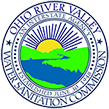Non-Point Source Pollution (NPS)
The term “non-point source” is defined to mean any source of water pollution that does not meet the legal definition of “point source” in section 502(14) of the Clean Water Act : The term “point source” means any discernible, confined and discrete conveyance, including but not limited to any pipe, ditch, channel, tunnel, conduit, well, discrete fissure, container, rolling stock, concentrated animal feeding operation, or vessel or other floating craft, from which pollutants are or may be discharged. This term does not include agricultural stormwater discharges and return flows from irrigated agriculture.
Non-point source (NPS) pollution, or polluted runoff, occurs from many diffuse sources of natural and human-made pollutants. It is generally a result of land runoff, atmospheric deposition, precipitation, snowmelt, drainage, and/or hydrologic modification. As water flows across and through the ground, it picks up and carries away pollutants and discharges them into rivers, lakes, groundwater, wetlands, and coastal waters. The Environmental Protection Agency (EPA) states that non-point source pollution is the leading remaining cause of water quality problems.
Examples of non-point source pollution include:
- Bacteria and nutrients from livestock, wildlife, pet waste, and human waste from septic tank malfunctions or combined sewer overflows
- Oil, grease, detergents, litter, excess fertilizers and pesticides from urban and residential areas
- Toxic chemicals and thermal pollution from industrial and energy production
- Sediment from eroding shorelines and mismanaged construction sites, forested land, and agricultural practices
ORSANCO’s Source Water Protection program was initiated to protect public drinking water supplies from contamination. Ohio River states are responsible for performing potential contaminant source inventories for drinking water intakes within their respective boundaries. ORSANCO coordinates and facilitates this information exchange between states. The Ohio River Watershed Pollutant Reduction program (1995-2010) looked at a specific set of pollutants in the Ohio River that cause significant impairment to its beneficial uses (drinking water, recreation, aquatic life, industrial supply). The program helped to establish innovative techniques to detect and analyze these contaminants. Read more about the study and its results here.
Read more about non-point source pollution and actions you can take to prevent pollution in your watershed:

